All Exams >
Electronics and Communication Engineering (ECE) >
Communication System >
All Questions
All questions of Pulse Modulation for Electronics and Communication Engineering (ECE) Exam
Which of the following Pulse time Modulation does not exist in practice?- a)PWM
- b)PAM
- c)PPM
- d)PFM
Correct answer is option 'D'. Can you explain this answer?
Which of the following Pulse time Modulation does not exist in practice?
a)
PWM
b)
PAM
c)
PPM
d)
PFM

|
Cstoppers Instructors answered |
PFM does not exist in practice
Additional Information
PWM
The amplitude and position of pulses are constant in modulated signal (PWM), but the width (or duration) of pulses varies proportionally with the amplitude of an analog useful signal.
The carrier signal is produced by a clock.
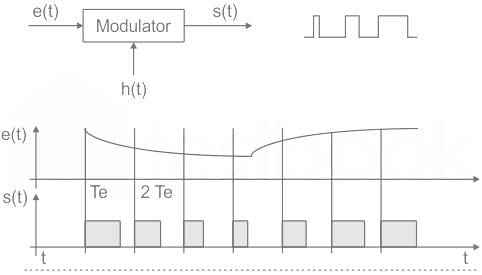
PWM
The amplitude and position of pulses are constant in modulated signal (PWM), but the width (or duration) of pulses varies proportionally with the amplitude of an analog useful signal.
The carrier signal is produced by a clock.

PPM
The amplitude and width of pulses are constant in a modulated signal (PPM), but the direction of pulses varies proportionally with the amplitude of analogical useful signal.
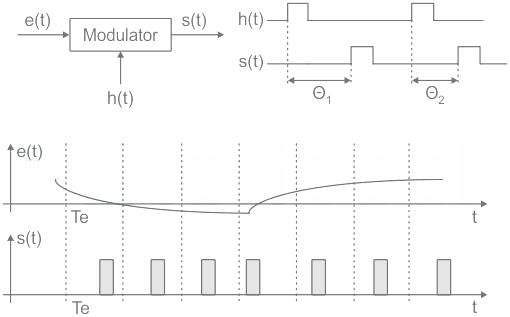
The amplitude and width of pulses are constant in a modulated signal (PPM), but the direction of pulses varies proportionally with the amplitude of analogical useful signal.

PAM
The width and location of pulses in a modulated signal (PAM) are constant, while the amplitude of pulses varies proportionally with the amplitude of an analogical useful signal.
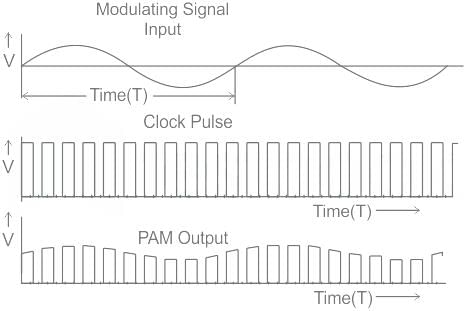
The width and location of pulses in a modulated signal (PAM) are constant, while the amplitude of pulses varies proportionally with the amplitude of an analogical useful signal.

The bandwidth of TV video plus audio signal is 4.5 MHz. If this signal is converted into PCM bit stream with 1024 quantization levels and the signal is sampled at the rate 20% above Nyquist rate, then the number of bits/sec of the resulting signal is- a)196 M bits/sec
- b)108 M bits/sec
- c)88 M bits/sec
- d)216 M bits/sec
Correct answer is option 'B'. Can you explain this answer?
The bandwidth of TV video plus audio signal is 4.5 MHz. If this signal is converted into PCM bit stream with 1024 quantization levels and the signal is sampled at the rate 20% above Nyquist rate, then the number of bits/sec of the resulting signal is
a)
196 M bits/sec
b)
108 M bits/sec
c)
88 M bits/sec
d)
216 M bits/sec
|
|
Sarita Yadav answered |
Given,
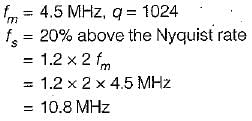
Now, quantization level, q = 2n
(n = No. of bits/sec)
∴ 2n = 1024 = 210
or, n = 10


Now, quantization level, q = 2n
(n = No. of bits/sec)
∴ 2n = 1024 = 210
or, n = 10

A PAM source generates four symbols 3 V, 1 V, -1 V and -3 V with probability of p(3) = p(-3) = 0.2 and p(1) = p(-1) = 0.3 respectively. The variance for the source will be- a)4.2 V
- b)3.2 V
- c)3.6 V
- d)4.6 V
Correct answer is option 'A'. Can you explain this answer?
A PAM source generates four symbols 3 V, 1 V, -1 V and -3 V with probability of p(3) = p(-3) = 0.2 and p(1) = p(-1) = 0.3 respectively. The variance for the source will be
a)
4.2 V
b)
3.2 V
c)
3.6 V
d)
4.6 V
|
|
Gaurav Bhandari answered |
Variance is a measure of how spread out the values of a random variable are around the mean. In this case, we are given a PAM (Pulse Amplitude Modulation) source that generates four symbols with different probabilities. We need to calculate the variance for this source.
The formula to calculate the variance of a discrete random variable is:
Var(X) = Σ(xi - μ)^2 * P(xi)
where Var(X) is the variance, xi is each possible value of the random variable, μ is the mean, and P(xi) is the probability of each value.
Let's calculate the variance step by step:
1. Calculate the mean:
The mean (μ) of a discrete random variable can be calculated by multiplying each value with its probability and summing them up:
μ = Σ(xi * P(xi))
In this case, the mean is:
μ = (3 V * 0.2) + (1 V * 0.3) + (-1 V * 0.3) + (-3 V * 0.2)
= 0.6 V + 0.3 V - 0.3 V - 0.6 V
= 0 V
2. Calculate the variance:
Using the formula mentioned earlier, we can calculate the variance:
Var(X) = Σ(xi - μ)^2 * P(xi)
Substituting the values, we get:
Var(X) = (3 V - 0 V)^2 * 0.2 + (1 V - 0 V)^2 * 0.3 + (-1 V - 0 V)^2 * 0.3 + (-3 V - 0 V)^2 * 0.2
= 9 V^2 * 0.2 + 1 V^2 * 0.3 + 1 V^2 * 0.3 + 9 V^2 * 0.2
= 1.8 V^2 + 0.3 V^2 + 0.3 V^2 + 1.8 V^2
= 4.2 V^2
Therefore, the variance for the given PAM source is 4.2 V^2.
Since the question asks for the variance in volts (V), we need to take the square root of the variance to get the variance in volts:
√(4.2 V^2) = 2.049 V
So, the correct option is A) 4.2 V.
The formula to calculate the variance of a discrete random variable is:
Var(X) = Σ(xi - μ)^2 * P(xi)
where Var(X) is the variance, xi is each possible value of the random variable, μ is the mean, and P(xi) is the probability of each value.
Let's calculate the variance step by step:
1. Calculate the mean:
The mean (μ) of a discrete random variable can be calculated by multiplying each value with its probability and summing them up:
μ = Σ(xi * P(xi))
In this case, the mean is:
μ = (3 V * 0.2) + (1 V * 0.3) + (-1 V * 0.3) + (-3 V * 0.2)
= 0.6 V + 0.3 V - 0.3 V - 0.6 V
= 0 V
2. Calculate the variance:
Using the formula mentioned earlier, we can calculate the variance:
Var(X) = Σ(xi - μ)^2 * P(xi)
Substituting the values, we get:
Var(X) = (3 V - 0 V)^2 * 0.2 + (1 V - 0 V)^2 * 0.3 + (-1 V - 0 V)^2 * 0.3 + (-3 V - 0 V)^2 * 0.2
= 9 V^2 * 0.2 + 1 V^2 * 0.3 + 1 V^2 * 0.3 + 9 V^2 * 0.2
= 1.8 V^2 + 0.3 V^2 + 0.3 V^2 + 1.8 V^2
= 4.2 V^2
Therefore, the variance for the given PAM source is 4.2 V^2.
Since the question asks for the variance in volts (V), we need to take the square root of the variance to get the variance in volts:
√(4.2 V^2) = 2.049 V
So, the correct option is A) 4.2 V.
Which of the following systems is analog?- a)PCM
- b)DM
- c)DPCM
- d)PAM
Correct answer is option 'D'. Can you explain this answer?
Which of the following systems is analog?
a)
PCM
b)
DM
c)
DPCM
d)
PAM

|
Cstoppers Instructors answered |
- Analog modulation is a process in which analog low-frequency baseband signals (like an audio or TV signal) are transmitted over a larger distance without getting faded away, by superimposing over a higher frequency carrier signal such as a radio frequency band.
- Different modulation techniques are explained with the help of the following block diagram:
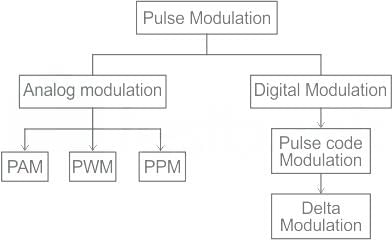
- If the amplitude of a pulse or duration of a pulse is varied according to the instantaneous values of the baseband modulating signal, then such a technique is called as Pulse Amplitude Modulation (PAM).
Assertion (A) : PCM has much better noise immunity as compared to PAM, PWM and PPM systems.
Reason (R) : PCM does not contain any information in the width or the position of the pulses.- a)Both A and R are true and R is the correct explanation of A.
- b)Both A and R are true but R is not the correct explanation of A.
- c)A is true but R is false.
- d)A is false but R is true.
Correct answer is option 'A'. Can you explain this answer?
Assertion (A) : PCM has much better noise immunity as compared to PAM, PWM and PPM systems.
Reason (R) : PCM does not contain any information in the width or the position of the pulses.
Reason (R) : PCM does not contain any information in the width or the position of the pulses.
a)
Both A and R are true and R is the correct explanation of A.
b)
Both A and R are true but R is not the correct explanation of A.
c)
A is true but R is false.
d)
A is false but R is true.

|
Pankaj Rane answered |
In practice, the transmitted pulses usually have slightly sloping sides (edges). As the noise is superimposed on them, the width and the position of the regenerated pulses is changed. This distorts the information contents in the PWM and PPM signals. Since PCM does not contain any information in the width or the position of the pulses, therefore PCM has much better noise immunity as compared to PAM, PWM and PPM systems. Hence, both assertion and reason are true and reason is the correct explanation of assertion.
The biggest disadvantages of PCM is- a)its inability to handle analog signals.
- b)the high error rate which its quantizing noise introduces.
- c)its incompatibility with TDM.
- d)the large bandwidths that are required for it.
Correct answer is option 'D'. Can you explain this answer?
The biggest disadvantages of PCM is
a)
its inability to handle analog signals.
b)
the high error rate which its quantizing noise introduces.
c)
its incompatibility with TDM.
d)
the large bandwidths that are required for it.

|
Garima Nambiar answered |
Disadvantages of PCM
1. Inability to Handle Analog Signals
PCM is a digital signal processing technique that converts analog signals into digital signals using quantization. However, it cannot handle analog signals directly, which means that analog signals need to be converted into digital signals before they can be processed using PCM.
2. High Error Rate
Quantization noise is introduced during the process of converting analog signals into digital signals. This noise can cause errors in the digital signal and can result in a high error rate. This can be a disadvantage of PCM, especially in systems where accuracy is critical.
3. Incompatibility with TDM
Time Division Multiplexing (TDM) is a technique used to transmit multiple signals over a single communication channel. However, PCM is not compatible with TDM, which means that it cannot be used in TDM systems.
4. Large Bandwidths Required
PCM requires a large bandwidth to transmit digital signals. This can be a disadvantage in situations where bandwidth is limited or expensive. Additionally, the large bandwidth requirement can limit the number of channels that can be transmitted simultaneously.
Conclusion
In conclusion, PCM has several disadvantages, including its inability to handle analog signals, high error rates due to quantization noise, incompatibility with TDM, and large bandwidth requirements. However, despite these disadvantages, PCM remains a widely used digital signal processing technique in various applications.
1. Inability to Handle Analog Signals
PCM is a digital signal processing technique that converts analog signals into digital signals using quantization. However, it cannot handle analog signals directly, which means that analog signals need to be converted into digital signals before they can be processed using PCM.
2. High Error Rate
Quantization noise is introduced during the process of converting analog signals into digital signals. This noise can cause errors in the digital signal and can result in a high error rate. This can be a disadvantage of PCM, especially in systems where accuracy is critical.
3. Incompatibility with TDM
Time Division Multiplexing (TDM) is a technique used to transmit multiple signals over a single communication channel. However, PCM is not compatible with TDM, which means that it cannot be used in TDM systems.
4. Large Bandwidths Required
PCM requires a large bandwidth to transmit digital signals. This can be a disadvantage in situations where bandwidth is limited or expensive. Additionally, the large bandwidth requirement can limit the number of channels that can be transmitted simultaneously.
Conclusion
In conclusion, PCM has several disadvantages, including its inability to handle analog signals, high error rates due to quantization noise, incompatibility with TDM, and large bandwidth requirements. However, despite these disadvantages, PCM remains a widely used digital signal processing technique in various applications.
Which of the following is NOT an advantage of Pulse Duration Modulation (PDM) recording?- a)It has a less complex electronic circuitry and therefore the reliability of such system is high.
- b)It has the ability to simultaneously record information from a large number of channels.
- c)It has high S/N ratio
- d)It has high accuracy due to the fact that it can be self-calibrated.
Correct answer is option 'A'. Can you explain this answer?
Which of the following is NOT an advantage of Pulse Duration Modulation (PDM) recording?
a)
It has a less complex electronic circuitry and therefore the reliability of such system is high.
b)
It has the ability to simultaneously record information from a large number of channels.
c)
It has high S/N ratio
d)
It has high accuracy due to the fact that it can be self-calibrated.
|
|
Sarita Yadav answered |
Concept:
Pulse Width Modulation (PWM):
As mentioned PWM is short form of Pulse Width Modulation in which width of pulse is proportional to amplitude of the modulating signal.
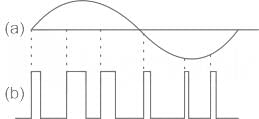
Pulse Width Modulation (PWM):
As mentioned PWM is short form of Pulse Width Modulation in which width of pulse is proportional to amplitude of the modulating signal.

Following are the benefits or advantages of PWM:
- Noise interference is less or minimum.
- The system is moderate in complexity to implement.
- It has moderate power efficiency among all three types.
- It supports higher power handling capability.
- It has high accuracy due to the fact that it can be self-calibrated.
- It has high S/N ratio.
- It has the ability to simultaneously record information from a large number of channels.
Following are the disadvantages of PWM:
- Instantaneous power of transmitter varies.
- The system requires semiconductor devices with low turn-ON and turn-OFF times. Hence they are very expensive.
- High switching losses due to higher PWM frequency.
From the given statements, 'It has a less complex electronic circuitry and therefore the reliability of such system is high' is NOT an advantage of Pulse Duration Modulation (PDM) recording.
Which of the following pulse modulation systems is analog?- a)PCM
- b)Differential PCM
- c)PWM
- d)Delta modulation
Correct answer is option 'C'. Can you explain this answer?
Which of the following pulse modulation systems is analog?
a)
PCM
b)
Differential PCM
c)
PWM
d)
Delta modulation

|
Tanvi Sarkar answered |
PAM, PWM and PPM are examples of analog pulse modulation techniques while PCM is a digital pulse modulation.
Consider a baseband binary PAM receiver shown below. The additive channel noise n(t) is white with power spectral density SN(f) = N0/2 = 10-20 W/Hz. The low-pass filter is ideal with unity gain and cutoff frequency 1 MHz. Let Yt, represent the random variable y(t1)
Yt = Ns if transmitted bit bk = 0
YK = a + Nk if transmitted bit bk = 1
where Nk represents the noise sample value. The noise sample has a probability density function, PN (n) = 0.5αe (This has mean zero and variance 2/α2), Assume transmitted bits lo be equiprobable and threshold z is set to a/2 = 10-6 V

‘The probability of bit error is- a)0.5 × e-3.5
- b)0.5 × e-5
- c)0.5 × e-7
- d)0.5 × e-10
Correct answer is option 'D'. Can you explain this answer?
Consider a baseband binary PAM receiver shown below. The additive channel noise n(t) is white with power spectral density SN(f) = N0/2 = 10-20 W/Hz. The low-pass filter is ideal with unity gain and cutoff frequency 1 MHz. Let Yt, represent the random variable y(t1)
Yt = Ns if transmitted bit bk = 0
YK = a + Nk if transmitted bit bk = 1
where Nk represents the noise sample value. The noise sample has a probability density function, PN (n) = 0.5αe (This has mean zero and variance 2/α2), Assume transmitted bits lo be equiprobable and threshold z is set to a/2 = 10-6 V

‘The probability of bit error is
Yt = Ns if transmitted bit bk = 0
YK = a + Nk if transmitted bit bk = 1
where Nk represents the noise sample value. The noise sample has a probability density function, PN (n) = 0.5αe (This has mean zero and variance 2/α2), Assume transmitted bits lo be equiprobable and threshold z is set to a/2 = 10-6 V

‘The probability of bit error is
a)
0.5 × e-3.5
b)
0.5 × e-5
c)
0.5 × e-7
d)
0.5 × e-10
|
|
Sarita Yadav answered |
Concept:
Consider the block diagram as shown below to represent the noise which is treated as error:

Consider the block diagram as shown below to represent the noise which is treated as error:

The received signal is:
r(t) = Si(t) + n(t)
The output of the filter is:
z(t) = ai(t) + n0(t)
ai(t): Signal component
n0(t): Noise component
The probability of error is represented in terms of the Q function:

Pe = Q[x]
When the pdf's are not having an equal width then the probability of error will not be the same for both symbols. In this case, the Bit error rate is calculated.
BER = P(1) × Pe1 + P(0) × Pe0
P(1): Probability when 1 is transmitted
P(0): Probability when 0 transmitted
Pe0: Probability of error when 0 transmitted
Pe1: Probability of error when 1 transmitted.
Calculation:
The system is defined as shown:
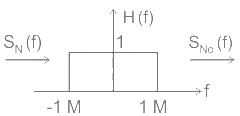
The given mean is 0 and variance is 2/α2
V[X] = E[X2] - (E[X])2
2/α2 = E[X2]
The area under the curve is:
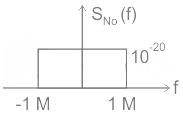
E[X2] = 10-20 × 2 × 106
2/α2 = 10-14 × 2
α2 = 1014
α = 107
Given Yt, represent the random variable y(t1)
Yt = Ns if transmitted bit bk = 0
YK = a + Nk if transmitted bit bk = 1 and threshold z is set to a/2 = 10-6 V
P(0) = P(1) = 1/2
Pe = P(1) × Pe1 + P(0) × Pe0
Pe1 calculation
We know that when the output signal is less than the threshold it is considered as 0 and there is an error when 1 is transmitted.
Yk < z ⇒ error
a + Nk < 10-6
Nk < -10-6


Pe0 calculation
We know that when the output signal is more than the threshold it is considered as 1 and there is an error when 0 is transmitted.
Yk > z ⇒ error
Ns > 10-6
Ns > -10-6
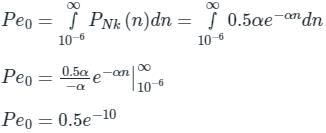
The probability of error is:

r(t) = Si(t) + n(t)
The output of the filter is:
z(t) = ai(t) + n0(t)
ai(t): Signal component
n0(t): Noise component
The probability of error is represented in terms of the Q function:

Pe = Q[x]
When the pdf's are not having an equal width then the probability of error will not be the same for both symbols. In this case, the Bit error rate is calculated.
BER = P(1) × Pe1 + P(0) × Pe0
P(1): Probability when 1 is transmitted
P(0): Probability when 0 transmitted
Pe0: Probability of error when 0 transmitted
Pe1: Probability of error when 1 transmitted.
Calculation:
The system is defined as shown:

The given mean is 0 and variance is 2/α2
V[X] = E[X2] - (E[X])2
2/α2 = E[X2]
The area under the curve is:

E[X2] = 10-20 × 2 × 106
2/α2 = 10-14 × 2
α2 = 1014
α = 107
Given Yt, represent the random variable y(t1)
Yt = Ns if transmitted bit bk = 0
YK = a + Nk if transmitted bit bk = 1 and threshold z is set to a/2 = 10-6 V
P(0) = P(1) = 1/2
Pe = P(1) × Pe1 + P(0) × Pe0
Pe1 calculation
We know that when the output signal is less than the threshold it is considered as 0 and there is an error when 1 is transmitted.
Yk < z ⇒ error
a + Nk < 10-6
Nk < -10-6


Pe0 calculation
We know that when the output signal is more than the threshold it is considered as 1 and there is an error when 0 is transmitted.
Yk > z ⇒ error
Ns > 10-6
Ns > -10-6

The probability of error is:

Consider a baseband binary PAM receiver shown below. The additive channel noise n(t) is white with power spectral density SN(f) = N0/2 = 10-20 W/Hz. The low-pass filter is ideal with unity gain and cutoff frequency 1 MHz. Let Yt, represent the random variable y(t1)
Yt = Ns if transmitted bit bk = 0
YK = a + Nk if transmitted bit bk = 1
where Nk represents the noise sample value. The noise sample has a probability density function, PN (n) = 0.5αe (This has mean zero and variance 2/α2), Assume transmitted bits lo be equiprobable and threshold z is set to a/2 = 10-6 V

Q. The value of the parameter α (in V-1) is- a)1010
- b)107
- c)1.414 × 10-10
- d)2 × 1020
Correct answer is option 'B'. Can you explain this answer?
Consider a baseband binary PAM receiver shown below. The additive channel noise n(t) is white with power spectral density SN(f) = N0/2 = 10-20 W/Hz. The low-pass filter is ideal with unity gain and cutoff frequency 1 MHz. Let Yt, represent the random variable y(t1)
Yt = Ns if transmitted bit bk = 0
YK = a + Nk if transmitted bit bk = 1
where Nk represents the noise sample value. The noise sample has a probability density function, PN (n) = 0.5αe (This has mean zero and variance 2/α2), Assume transmitted bits lo be equiprobable and threshold z is set to a/2 = 10-6 V

Q. The value of the parameter α (in V-1) is
Yt = Ns if transmitted bit bk = 0
YK = a + Nk if transmitted bit bk = 1
where Nk represents the noise sample value. The noise sample has a probability density function, PN (n) = 0.5αe (This has mean zero and variance 2/α2), Assume transmitted bits lo be equiprobable and threshold z is set to a/2 = 10-6 V

Q. The value of the parameter α (in V-1) is
a)
1010
b)
107
c)
1.414 × 10-10
d)
2 × 1020

|
Cstoppers Instructors answered |
Concept:
The statistical averages Mean and Variance are called as 'first order moment' and 'second-order moment' respectively.
Variance represents the total power of the random signal.


Total power can be determined as the area of the curve.
When the input is passed through a system the output is shown by:
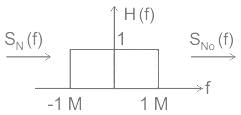
SN(f): Input noise PSD
SN0(f): Output noise PSD
H(f): system response
Calculation:
The system is defined as shown:
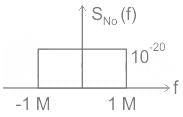
The statistical averages Mean and Variance are called as 'first order moment' and 'second-order moment' respectively.
Variance represents the total power of the random signal.


Total power can be determined as the area of the curve.
When the input is passed through a system the output is shown by:

SN(f): Input noise PSD
SN0(f): Output noise PSD
H(f): system response
Calculation:
The system is defined as shown:

The given mean is 0 and variance is 2/α2
V[X] = E[X2] - (E[X])2
2/α2 = E[X2]
The area under the curve is:
E[X2] = 10-20 × 2 × 106
2/α2 = 10-14 × 2
α2 = 1014
α = 107
V[X] = E[X2] - (E[X])2
2/α2 = E[X2]
The area under the curve is:
E[X2] = 10-20 × 2 × 106
2/α2 = 10-14 × 2
α2 = 1014
α = 107
The Nyquist rate for a continuous-time signal (x) is
x(t) = 6cos50πt + 20sin300πt - 10cos100πt- a)300 Hz
- b)150 Hz
- c)100 Hz
- d)50 Hz
Correct answer is option 'A'. Can you explain this answer?
The Nyquist rate for a continuous-time signal (x) is
x(t) = 6cos50πt + 20sin300πt - 10cos100πt
x(t) = 6cos50πt + 20sin300πt - 10cos100πt
a)
300 Hz
b)
150 Hz
c)
100 Hz
d)
50 Hz

|
Raksha Nair answered |
Given,

Also,

Comparing equations (I) and (II), we have:

Thus, the highest frequency component of the given message signal will be

∴ Nyquist rate = 2fmax = 2 x 150 = 300 Hz

Also,

Comparing equations (I) and (II), we have:

Thus, the highest frequency component of the given message signal will be

∴ Nyquist rate = 2fmax = 2 x 150 = 300 Hz
A speech signal is sampled a rate of 20% above the Nyquist rate. The signal has a bandwidth of 10 kHz. The sample is quantized into 1024 levels and then transmitted through 8-level PAM over an AWGN baseband channel. The bandwidth required for transmission is ______- a)80 kHz
- b)44 kHz
- c)40 kHz
- d)34 kHz
Correct answer is option 'A'. Can you explain this answer?
A speech signal is sampled a rate of 20% above the Nyquist rate. The signal has a bandwidth of 10 kHz. The sample is quantized into 1024 levels and then transmitted through 8-level PAM over an AWGN baseband channel. The bandwidth required for transmission is ______
a)
80 kHz
b)
44 kHz
c)
40 kHz
d)
34 kHz
|
|
Sakshi Chauhan answered |
Sampling rate
The Nyquist rate is the minimum sampling rate required to accurately represent a signal without any loss of information. According to the Nyquist-Shannon sampling theorem, the sampling rate should be at least twice the bandwidth of the signal.
Given that the signal has a bandwidth of 10 kHz, the Nyquist rate would be 2 * 10 kHz = 20 kHz.
Sampling rate above the Nyquist rate
In this case, the signal is sampled at a rate 20% above the Nyquist rate. Therefore, the sampling rate would be 1.2 * 20 kHz = 24 kHz.
Quantization levels
After sampling, the signal is quantized into 1024 levels. Quantization is the process of reducing the number of amplitude levels in a signal. It allows for the digital representation of the signal.
Pulse Amplitude Modulation (PAM)
The quantized samples are then transmitted using 8-level PAM over an AWGN (Additive White Gaussian Noise) baseband channel. PAM is a modulation technique where the amplitude of a series of pulses is varied to represent the information.
Bandwidth required for transmission
The bandwidth required for transmission can be calculated based on the highest frequency component in the signal. In this case, the bandwidth of the original signal is given as 10 kHz.
However, during the PAM modulation process, additional frequency components are introduced. The bandwidth required for PAM can be estimated using Carson's rule, which states that the bandwidth is equal to the sum of the highest frequency component and twice the modulation frequency.
In this case, the highest frequency component is 10 kHz, and the modulation frequency is equal to the sampling rate of 24 kHz. Therefore, the bandwidth required for transmission would be 10 kHz + 2 * 24 kHz = 58 kHz.
However, it is important to note that the bandwidth required for transmission cannot be less than the Nyquist rate. Since the sampling rate is already 20% above the Nyquist rate (24 kHz), the required bandwidth for transmission would be equal to the sampling rate, i.e., 24 kHz.
Therefore, the correct answer is option A) 80 kHz.
Study the given input signal and match the columns.

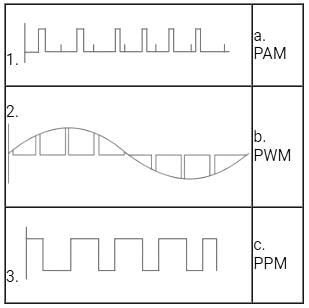
- a)1 - c, 2 - b, 3 - a
- b)1 - a, 2 - c, 3 - b
- c)1 - b, 2 - a, 3 - c
- d)1 - c, 2 - a, 3 - b
Correct answer is option 'D'. Can you explain this answer?
Study the given input signal and match the columns.




a)
1 - c, 2 - b, 3 - a
b)
1 - a, 2 - c, 3 - b
c)
1 - b, 2 - a, 3 - c
d)
1 - c, 2 - a, 3 - b
|
|
Luminary Institute answered |
PFM does not exist in practice
Additional Information
PWM
The amplitude and position of pulses are constant in modulated signal (PWM), but the width (or duration) of pulses varies proportionally with the amplitude of an analog useful signal.
The carrier signal is produced by a clock.
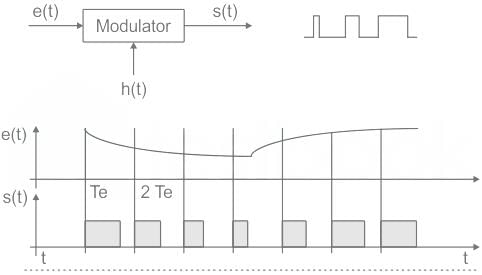
PWM
The amplitude and position of pulses are constant in modulated signal (PWM), but the width (or duration) of pulses varies proportionally with the amplitude of an analog useful signal.
The carrier signal is produced by a clock.

PPM
The amplitude and width of pulses are constant in a modulated signal (PPM), but the direction of pulses varies proportionally with the amplitude of analogical useful signal.
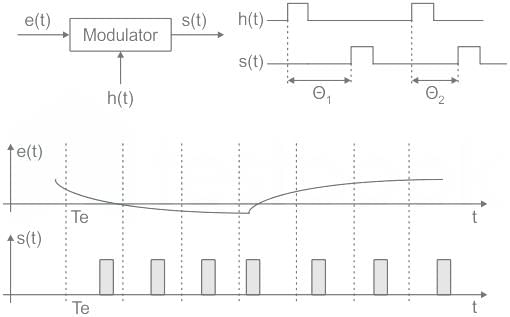
The amplitude and width of pulses are constant in a modulated signal (PPM), but the direction of pulses varies proportionally with the amplitude of analogical useful signal.

PAM
The width and location of pulses in a modulated signal (PAM) are constant, while the amplitude of pulses varies proportionally with the amplitude of an analogical useful signal.
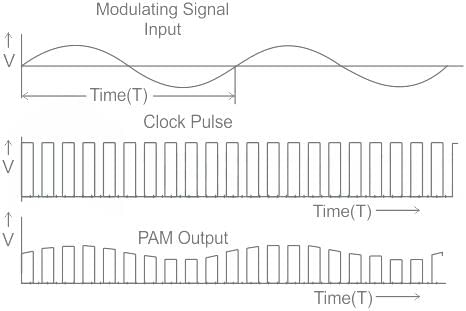
Hence from the above option (d) is correct
The width and location of pulses in a modulated signal (PAM) are constant, while the amplitude of pulses varies proportionally with the amplitude of an analogical useful signal.

Hence from the above option (d) is correct
Which filter is used to detect the PAM signal?- a)Low Filter
- b)High Pass Filter
- c)Bandpass filter
- d)All-Band Pass Filter
Correct answer is option 'A'. Can you explain this answer?
Which filter is used to detect the PAM signal?
a)
Low Filter
b)
High Pass Filter
c)
Bandpass filter
d)
All-Band Pass Filter
|
|
Sarita Yadav answered |
PAM (Pulse Amplitude Modulation):
- It is a technique in which the amplitude of each pulse is controlled by the instantaneous amplitude of the modulation signal.
- It is a modulation system in which the signal is sampled at regular intervals and each sample is made proportional to the amplitude of the signal at the instant of sampling.
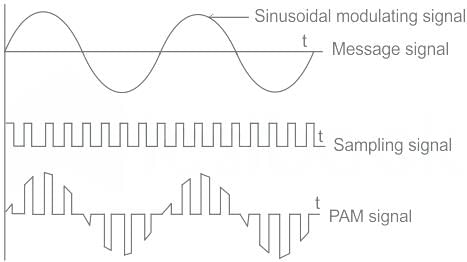
- The demodulation of the PAM signals is done by using a Low-pass filter as shown:

Assertion (A) : The signaling rate and transmission channel bandwidth is quite large for delta modulation compared to PCM.
Reason (R) : There is no analog to digital converter required in delta modulation unlike PCM.- a)Both A and R are true and R is the correct explanation of A.
- b)Both A and R are true but R is not the correct explanation of A.
- c)A is true but R is false.
- d)A is false but R is true.
Correct answer is option 'D'. Can you explain this answer?
Assertion (A) : The signaling rate and transmission channel bandwidth is quite large for delta modulation compared to PCM.
Reason (R) : There is no analog to digital converter required in delta modulation unlike PCM.
Reason (R) : There is no analog to digital converter required in delta modulation unlike PCM.
a)
Both A and R are true and R is the correct explanation of A.
b)
Both A and R are true but R is not the correct explanation of A.
c)
A is true but R is false.
d)
A is false but R is true.

|
Mira Mishra answered |
Since, the delta modulation transmits only one bit for one sample, therefore the signaling rate and transmission channel bandwidth is quite small for delta modulation compared to PCM, Hence, assertion is a false statement.
The transmission and receiver implementation is very simple for delta modulation since there is no A/D converter required in delta modulation unlike PCM. Hence, reason is a true statement.
The transmission and receiver implementation is very simple for delta modulation since there is no A/D converter required in delta modulation unlike PCM. Hence, reason is a true statement.
The output signal to noise ratio (SNR) of a 10-bit PCM was found to be 30 dB. The desired SNR is 42 dB. It was decided to increase the SNR to the desired value by increasing the number of quantization levels. The percentage increase in the transmission bandwidth required for this SNR is- a)20%
- b)15%
- c)10%
- d)5%
Correct answer is option 'A'. Can you explain this answer?
The output signal to noise ratio (SNR) of a 10-bit PCM was found to be 30 dB. The desired SNR is 42 dB. It was decided to increase the SNR to the desired value by increasing the number of quantization levels. The percentage increase in the transmission bandwidth required for this SNR is
a)
20%
b)
15%
c)
10%
d)
5%

|
Bhargavi Deshpande answered |
Given, SNR = 30 dB, n = 10,
Desired value of SNR = 42 dB
With the increase in n by 1 bit, the value of SNR increases by 6 dB. Therefore, to increase the value of SNR by 12 dB, it is necessary to increase n by 2,
∴ n = 10 + 2 = 12
Now, BW of PCM system = 1/2 nfs
Therefore, BW with n = 10 is

and BW for n = 12 is


Desired value of SNR = 42 dB
With the increase in n by 1 bit, the value of SNR increases by 6 dB. Therefore, to increase the value of SNR by 12 dB, it is necessary to increase n by 2,
∴ n = 10 + 2 = 12
Now, BW of PCM system = 1/2 nfs
Therefore, BW with n = 10 is

and BW for n = 12 is


The Nyquist interval for the signal

- a)0.1 ms
- b)0.2 ms
- c)0.3 ms
- d)0.4 ms
Correct answer is option 'B'. Can you explain this answer?
The Nyquist interval for the signal


a)
0.1 ms
b)
0.2 ms
c)
0.3 ms
d)
0.4 ms

|
Rutuja Pillai answered |
Given signal is
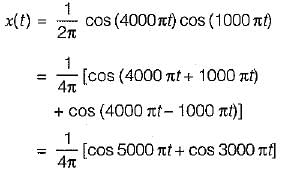
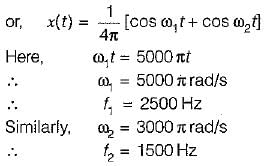
Hence, the maximum frequency present in x(t) is f1= 2500 Hz
∴ Nyquist rate is given as
fs = 2fm
(where, fm = Maximum frequency present in the signal)
Here, fm = f1 = 2500 Hz
∴ Nyquist rate is

Nyquist interval is given as
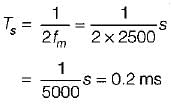


Hence, the maximum frequency present in x(t) is f1= 2500 Hz
∴ Nyquist rate is given as
fs = 2fm
(where, fm = Maximum frequency present in the signal)
Here, fm = f1 = 2500 Hz
∴ Nyquist rate is

Nyquist interval is given as

A PAM signal can be detected by using- a)An ADC
- b)An integrator
- c)A band pass filter
- d)A high pass filter
Correct answer is option 'B'. Can you explain this answer?
A PAM signal can be detected by using
a)
An ADC
b)
An integrator
c)
A band pass filter
d)
A high pass filter
|
|
Sarita Yadav answered |
A PAM signal is demodulated using an integrator. Signals having same width but different amplitudes produce different values at the output of an integrator.
A sine wave of frequency fm and amplitude Am is applied to a delta modulator having step size Δ. The slope overload distortion will not occur if- a)

- b)

- c)both (a) and (b)
- d)

Correct answer is option 'C'. Can you explain this answer?
A sine wave of frequency fm and amplitude Am is applied to a delta modulator having step size Δ. The slope overload distortion will not occur if
a)

b)

c)
both (a) and (b)
d)


|
Ritika Menon answered |
Let, x(t) = Am sin (2πfmt)
The slope of x(t) will be maximum when derivative of x(t) w.r.t. 't' will be maximum.
Maximum slope = Δ/Ts
Hence, for slope overload distortion not to occur,

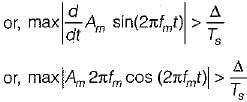

Hence, slope overload distortion doesn’t occur if
The slope of x(t) will be maximum when derivative of x(t) w.r.t. 't' will be maximum.
Maximum slope = Δ/Ts
Hence, for slope overload distortion not to occur,



Hence, slope overload distortion doesn’t occur if

Chapter doubts & questions for Pulse Modulation - Communication System 2025 is part of Electronics and Communication Engineering (ECE) exam preparation. The chapters have been prepared according to the Electronics and Communication Engineering (ECE) exam syllabus. The Chapter doubts & questions, notes, tests & MCQs are made for Electronics and Communication Engineering (ECE) 2025 Exam. Find important definitions, questions, notes, meanings, examples, exercises, MCQs and online tests here.
Chapter doubts & questions of Pulse Modulation - Communication System in English & Hindi are available as part of Electronics and Communication Engineering (ECE) exam.
Download more important topics, notes, lectures and mock test series for Electronics and Communication Engineering (ECE) Exam by signing up for free.
Communication System
14 videos|44 docs|30 tests
|

Contact Support
Our team is online on weekdays between 10 AM - 7 PM
Typical reply within 3 hours
|
Free Exam Preparation
at your Fingertips!
Access Free Study Material - Test Series, Structured Courses, Free Videos & Study Notes and Prepare for Your Exam With Ease

 Join the 10M+ students on EduRev
Join the 10M+ students on EduRev
|

|
Create your account for free
OR
Forgot Password
OR
Signup on EduRev and stay on top of your study goals
10M+ students crushing their study goals daily










